Fisheries and Aquaculture Journal
Open Access
ISSN: 2150-3508
ISSN: 2150-3508
Research Article - (2021)Volume 12, Issue 3
The fisheries sector of Bangladesh represents one of the most dynamic food-producing sectors with the largest flooded wetland and the 3rd largest aquatic biodiversity in Asia after China and India. This paper presents the performance of shrimp production a fisheries sub-sector in Bangladesh using data collected from the Department of Fisheries (DoF), and related field level information. The findings describe the recent status of shrimp production and its economic contribution as an aquaculture sub-sector (2017-2018). This study suggests that standard operating procedure is the prerequisite for shrimp culture along with the scientific and technical development. From 2010 to 2018, though frozen shrimp products export decreased from 51,599 MT to 36,167.77 MT the total value increased $340.48 million to $416.22 million respectively. From the last 10 years shrimp production has been increased gradually and 2017-2018 it has increased by 3.23% than 2015-2016. Therefore, there is a considerable potentiality for increasing export earnings from shrimp products in the future but for this, the present deficiencies should be well addressed and industries should positively respond to the demand of the global market. Additionally, our study will help to get a clear picture and valuable information about shrimp production in Bangladesh which is important for shrimp farming and catch-up the trade market.
Bangladesh; Frozen shrimp export; Shrimp production statistics; Shrimp sources
Aquaculture is a world-wide activity and measured as a major financial and food production sector in Asia. It is an important protein source for human consumption. According to FAO Yearbook Fishery and Aquaculture statistics 2017, the fisheries sector is more demanding than all other food-producing sectors. Global fisheries resources are continued to rise and reached 172.6 million tons in 2017, with an increase of 4.1% compared with 2016. Normally developed countries act as importer whereas developing countries act as exporter categories. Aquaculture production is dominated by Asian developing countries in the Pacific region, which accounts for 89% by volume). In Bangladesh itself, it is estimated that total aquaculture production will reach 4.5 million metric tons by 2021 to fulfill the target of Vision-2021 (Yearbook of Fisheries Statistics of Bangladesh, 2017-18) [1].
The worldwide fisheries market is greatly dominated by shrimp production. Fish market report 2019 surveyed that shrimp is the second largest traded seafood in the world after salmon fisheries [1]. Shrimps commodities traded around 17 percent in the total volume of seafood trading in 2017 [1]. Shrimp has been farming in Bangladesh using traditional low-density methods like extensive or semi-intensive culture [2]. In south-east Asia, the use of brackish water pond on a small scale is very popular for shrimp culture. The small scale ponds are used for monoculture or poly-culture such as; paddy cum culture or fish cum culture in the traditional way. The poly-culture of shrimp with tilapia [3] or other herbivorous carp fish may provide a potential approach for shrimp industries. Paddy, shrimp, and fish culture which could be an important approach in the fisheries sector especially for populated countries like Bangladesh, China, India and other Asian countries. This type of culture will encourage the farmer because they can get two or more crops at a time.
Bangladesh is irrigated by rivers with inland water body which are the significant habitat of wild shrimp resources and potential shrimp culture sources. The favorable geographic position and environment of Bangladesh come with a large habitat of shrimp species and provides plenty of support to the potential fisheries [4]. The sources of shrimp production in Bangladesh except marine are rivers, culture farms, and flood plain area. Most of the production obtains from the culture farm of Black tiger shrimp (P. monodon) and Freshwater prawn (M. rogenbergii) are two major divisions Khulna (80.44%) and Chattogram (17.23%) the coastal region in Bangladesh (Yearbook of Fisheries Statistics of Bangladesh, 2017-18). Though shrimp culture production has been increasing gradually but the export quantity decreasing straightly from the last few years [5]. As fisheries sub-sector shrimp production has ample possibility to strengthen the national economy. However, further research is required for shrimp culture to improve their food consumption rate, taste quality, disease control [6], and overall production ensuring the eco-friendly environment. In this case government, non- government organizations, industries, and researchers can play a vital role in the wide-ranging advancement of this sector according to the demand of the global market. Furthermore, fisheries statistical information is very important for planning and managing the possible risks and deficiencies during farming. The aim of our study was to identify the present shrimp culture condition and status to accelerate the cultivation of shrimp by concerning the relative personnel.
Data collection sources
Department of Fisheries (DoF) field officers were responsible for data collection. Data was collected from Inland Fisheries in Bangladesh including wild-caught and culture shrimp which covers all shrimp species related to (1) inland open water sources, (2) inland closed water sources, and (3) marine sources. Inland open water sources consist of rivers, lakes, dead rivers, floodplain, and coastline areas whether inland closed water sources consist of culture ponds, seasonal water bodies, and cage and pen culture in river or lake. The local name of the shrimp culture farm is called Gher in south-west Bangladesh and Bheri in south-east Bangladesh. Marine sources consist of a wildcaught area on the coastline near to Chattogram and Khulna division. Besides, data are also collected from shrimp hatcheries. Bangladesh Fisheries Development Corporation (BFDC) and Bangladesh Frozen Foods Exporters Association (BFFEA) were the key sources of export statistics of shrimp products (bffea.net: access 2020). Collecting data from these sources, the collected data are presented for necessary cleaning, screening, editing, compilation, and then for analysis. Members of the Fisheries Resources Survey System (FRSS) were involved in this data accumulation for an annual shrimp production report that is included in the Yearbook of Fisheries Statistics of Bangladesh 2017-2018.
Data collection methods
Data collection methods were consisting of (1) catch assessment survey, (2) fixed sample village, and (3) analysis and record keeping. A catch assessment survey is formulated to estimate yearly shrimp production for statistical purposes. Each of the catch assessment surveys is designed as a sample survey of three or two-stage sampling with methodical sampling or random sampling by the DoF. Sample villages were used to calculate various factors framed by division, districts, and exclusive areas to provide a complete list of the sampling unit and record was kept with basic information such as shrimp production per units, the number of shrimp culture farms and the number of shrimp trawlers or boats. A minimum unit is necessary for sampling which depends on the number of shrimp farms, fishermen, boat, and gear. Sample villages were carefully selected by Fisheries Survey Officer (FSO) and updated to use for several years as a track of annual shrimp production.
Data processing and record keeping
Collected data forms obtained from the catch assessment survey were being processed at the headquarters of DoF for raw record keeping. The completed survey forms are thoroughly checked at field level (district and divisional). Then data were being processed by the Fisheries Resources Survey System (FRSS) for electronic record keeping. In this paper graphical analysis was performed by originPro 2016. The data were collected and summarized for shrimp production from the Yearbook of Fisheries Statistics of Bangladesh 2017-2018.
Area wise shrimp production
Bangladesh is the 5th leading fish producing country in the world (FAO. 2019). In 2017-2018 the total fisheries production was 4276641 MT, whereas only shrimp production was 254367 MT (DoF. 2018). The shrimp production covered 258681 hectares of farming area with a productivity of 983 kg/hectare and 5.95% of total fisheries production. Inland shrimp including big and small shrimp production from different areas like river contributed 7.26% percent (18461 MT), culture farm contributed 51.34% (130589 MT) and flood plain area contributed 19.25% (48956 MT) and rest of the shrimp production 22.16% (56361 MT) was contributed from marine sources. Overall growth performance of total shrimp production in 2017-2018 from inland aquaculture shows a moderately increased trend (Figure 1). The shrimp production of 2018 has increased almost 2 times than the production of 2006 and increased by 3.23% than in 2017. The most shrimp farming divisions are respectively Khulna, Chattogram, Barishal, Dhaka, Rajshahi, Rangpur, Sylhet, and Mymensingh. Seasonal watercovered areas like haor and non-haor (local name) are also suitable for freshwater shrimp farming [7]. Shrimp aquaculture in coastal areas in Khulna, Barishal, and Chattogram is the best habitat for brackish water shrimp (Figure 2A-2B) [8].
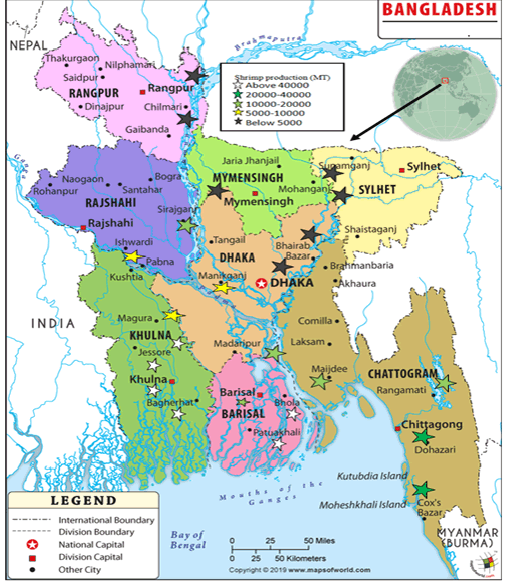
Figure 1: Bangladesh map, Starmark indicates the productivity of shrimp (Source: Fisheries Statistics of Bangladesh).

Figure 2a: Big and small shrimp production from key inland areas in Bangladesh (river, culture farm and flood plain); Big shrimp includes 4 different species: Bagda (Penaeus monodon), Galda (Macrobrachium rosenbergii), Harina (Metapenaeus monoceros), and Chaka (Fenneropenaeus indicus). Small shrimp includes: Gura icha (Macrobrachium lamarrei), Goda chingri (Macrobrachium dolichodactylu), Pata chingri (Macrobrachium rude), Danua chingri (Macrobrachium lancesteri), and Dimua icha (Macrobrachium villosimanus).

Figure 2b: Shrimp production from 2006 to 2018 statistics has shown positive upwards trends. It’s performed by yearly basis and quantity present in Metric Ton (MT).
Division and species wise shrimp production
Brackish and freshwater areas are suitable for sustainable shrimp farming in Bangladesh (Farkan et al., 2017). Shrimp cultivation areas spread over 8 divisions; Dhaka, Mymensingh, Khulna, Barishal, Sylhet, Rajshahi, Rangpur, and Chattogram. The coastline divisions are Khulna, Chattogram and Barishal where the production rate is significantly higher than other divisions. The year of 2017-2018 total shrimp production in these divisions; Khulna, Chattogram, and Barishal were 85.05% (228661.88 MT), 11.34% (25349.35 MT), and 2.93% (9762.49 MT) respectively (Figure 3A-3C). Graphical statistics showed that in Khulna and Chattogram brackish water shrimp Bagda (P. monodon) production was higher than freshwater shrimp but in other divisions it were opposite-ward (Figure 3C). Total shrimp production areas in these divisions; Khulna, Chattogram, and Barishal were 80.44% (208086.6 Hectares), 17.23% (44576.58 Hectares), and 1.78% (4607.14 Hectares) respectively (Figure 3C) (Sources: Yearbook of Fisheries Statistics of Bangladesh 2017-2018).
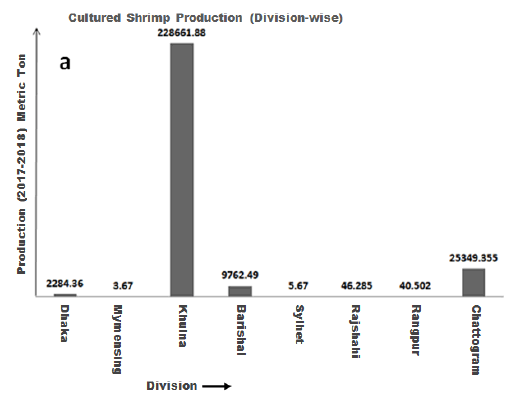
Figure 3a: Division-wise culture shrimp production in Bangladesh.
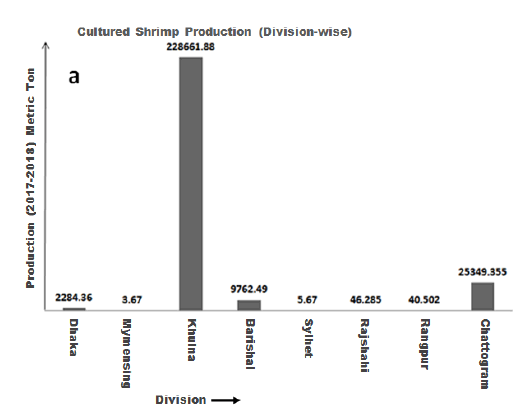
Figure 3b: Species wise culture shrimp production in different divisions.
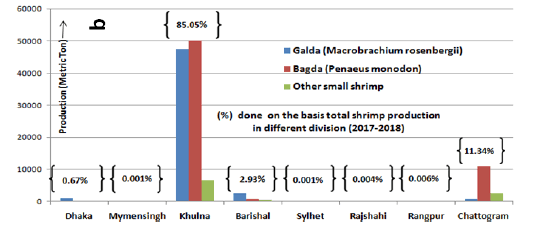
Figure 3c: Division wise culture area for two different species; Bagda (Penaeus monodon) and Galda (Macrobrachium rosenbergii). It’s performed by the production year 2017-2018, production present in Metric Tons (MT) and the area present in Hectare. (Sources: Yearbook of Fisheries Statistics of Bangladesh 2017-2018).
Frozen shrimp export status
Shrimp exports quantity has been decreasing from last few consecutive years 2011 to 2018 with the face of continual low demand in the global market for the Bangladeshi farmed shrimp. Whiteleg shrimp (L. Vannamei) is dominating the world market because of its low prices compared to Black tiger (P. monodon) and Giant freshwater prawn (M. rogenbergii) (Research and Markets, 2019). Most of the Asian countries and some Latin American countries are farming Whiteleg shrimp (FAO Yearbook; Fishery and Aquaculture Statistics 2017) (Table 1). Bangladesh is falling behind in this competition of Whiteleg shrimp farming. Whiteleg shrimp is sold $2-$2.5 less than the prices of Black tiger (P. monodon) per pound in the global market (Source: Bangladesh Frozen Foods Exporters Association news portal). The demands of P. monodon and M. rogenbergii have been declining from the last 5-7 years owing to the increased value. The graphical statistics of the last 7 years indicate that, though the export quantity continual declining 34.11% from the fiscal year 2011 to 2018 the export value decreases by 1.15% with a little fluctuation. In the fiscal year 2002 Bangladesh export shrimp product was about $170 million and fiscal year 2014 it was on peak $486.05 million. The total export value decreases to $416.22 million in the 2018 fiscal year due to the tremendous decline of export quantity (Figure 4A-4B).
| Year | Export | quantity | Export Value growth |
|---|---|---|---|
| growth (%) | (%) | ||
| 2003 | 22.02 | 18.79 | |
| 2004 | 16.49 | 25.17 | |
| 2005 | 8.36 | 5.98 | |
| 2006 | 5.98 | 18.27 | |
| 2007 | 8.2 | 10.89 | |
| 2008 | -6.47 | -4.29 | |
| 2009 | 0.92 | -4.18 | |
| 2010 | 2.44 | 5.14 | |
| 2011 | 6.38 | 23.67 | |
| 2012 | -12.54 | 2.02 | |
| 2013 | 4.85 | -7.25 | |
| 2014 | -5.36 | 22 | |
| 2015 | -7.04 | -12.62 | |
| 2016 | -8.02 | 0 | |
| 2017 | -2.51 | 2.32 | |
| 2018 | -8.91 | -4.22 |
Table 1: Frozen shrimp export quantity and value (% has done for each year compared with the previous year); Sources: Yearbook of Fisheries Statistics of Bangladesh 2017-2018.
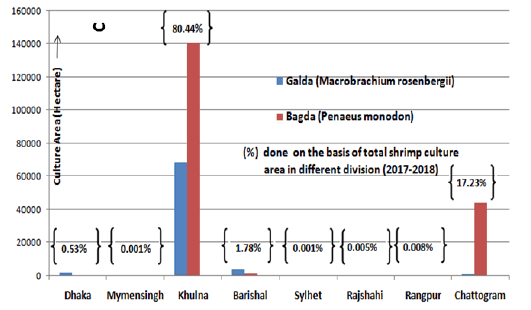
Figure 4a: Frozen shrimp export quantity fiscal year 2002 to 2018.
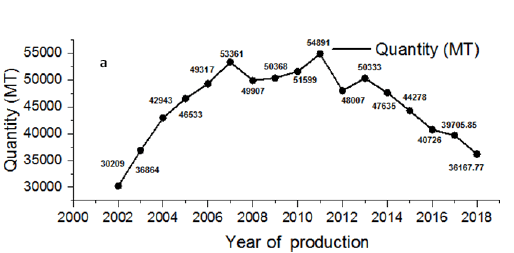
Figure 4b: Frozen shrimp export value fiscal year 2002 to 2018. 1$=84.74 BDT (source: XE rate 2020/01/25) $=USD, BDT=Bangladeshi currency (taka), and MT=Metric ton.
Shrimp is one of the major export items in Bangladesh after textile and footwear (EPB-2020). The most farming shrimp species in Bangladesh are Galda (M. rogenbergii) and Bagda (P. monodon). Frozen shrimp export statistic 2017-2018 has stated that, Bagda (P. monodon) production was 72.79% (26325.87 MT) with export value 77.13% ($321.03 million) of total shrimp statistic; whether Galda (M. rogenbergii) production was 16.17% (5848.48 MT) with export value 16.08% ($66.92 M) and others species export quantity were 11.04% (3993.42 MT) with export value 6.79% ($28.27 million) (Table 2). According to interview from Md Masudur Rahman (managing director of Sea Fresh Ltd, a processor and exporter, Bangladesh), he said now a day local people can also afford to buy shrimp that could not be imagined a decade ago. He also added, now traders are selling -1 ($10-$12) in at $8.70 lb-1 in the year 2016 but now it has reduced to $6, said Hossain (the managing director of Sobi Fish Processing Industries Ltd, Bangladesh). At present, domestic demand for shrimp is very strong, and the prices in the domestic markets in Bangladesh are higher than those in the international market. So this may be the possible issue for decreasing shrimp export in the global market. Coastal area management [9] and coastal fisheries laws [10] should be strict to produce quality shrimp.
| Species | Quantity (metric ton) | % in shrimp export quantity | Export value (million $) | % in shrimp export earning |
|---|---|---|---|---|
| Galda (M. rogenbergii) | 5848.48 | 16.17 | 66.92 | 16.08 |
| Bagda (P. monodon) | 26325.87 | 72.79 | 321.03 | 77.13 |
| others | 3993.42 | 11.04 | 28.27 | 6.79 |
| Total | 36167.77 | 416.22 |
Table 2:Species wise frozen shrimp export statistic 2017-2018.
Shrimp farming of Bangladesh face various challenges like overcatching and resources degradation. Different factors are responsible for shrimp resources degradation such as house or roads construction, improper drainage, natural calamities, using of fertilizers or pesticides, environment pollution etc. [10]. As a result the water areas, previously rich in shrimp, now became scanty. The blockage of water bodies may adversely affect the spawning of many indigenous shrimp species. Development projects and awareness programs should be conducted for increasing production and promotion of farming. Proper policy should be established and maintained for shrimp and wetland sanctuaries in certain eco-friendly areas such as Sundarbans, lakes, floodplain, rivers, and coastal areas. Gear restriction and species restriction may hinder the shrimp production. To increase shrimp production and promote business-friendly distribution channel through adopting Good Aquaculture Practices (GAP), cluster farming approach is the time demand. The Bangladesh government has taken initiative to maintained quality standards in all stages of shrimp production, processing and export. Department of Fisheries (DoF) has a strong monitoring team in the shrimp supply chain to ensure health safety for the consumers. It is pleasant that total shrimp production has been increased from 127,923 MT in 2006 to 254,367 MT in 2018 (DoF-2018). More emphasis should be given on hygiene and sanitation to ensure safe shrimp product distribution in the local as well as in global market [11-15].
The inland aquaculture production may be inhibited by three problems associated with seed, feed, and service (Bangladesh Planning Commission, 2016). To overcome these challenges, it is necessary to maintain the quality of brood-stocks of shrimp species preserving the breeding, spawning, rearing, and grow out areas to cover-up the whole lifecycle and reproduction process. Production, shrimp feed, feed value, vitamin premix, and other essential inputs should be pure and constantly monitored by the government. Production promoted intensive culture should be included in shrimp. The sustainable development of shrimp resources is hindered by the lack of knowledge and information like a species-wise stocking, breeding ground, grow out phases, seasonal duration, over-fishing, and mismanagement. Step to overcome these rapid assessments of shrimp stocks by fisheries policy needed to ensure compliance to protect spawn and juvenile. The government has taken some effective steps to increase shrimp production like expanding shrimp culture areas, catching policy for open water fishery, accelerating shrimp farming through modern technique, research and development, private sector promotion, improving shrimp marketing and processing technology, and quality control. Fishery’s statistical information especially for shrimp is very important for planning, managing, and exporting. The present shrimp culture condition and status will help to evaluate potential risks and deficiencies during farming. Our study will help to accelerate shrimp cultivation by giving a clear picture and valuable information to the relative personnel [16-18].
Bangladesh fishery has a great scope of development to support the national economy by shrimp production. In this sub-sector government concern and research can play a positive role in wide-ranging advancement. For the overall management of the shrimp sector, DoF could modernize their development projects toward the sustainable culture and production of shrimp ensuring nutrition value. The Planning accuracy of statistical information is a prerequisite to determine the possible risk in shrimp production and export. Human resource development is mandatory for the Department Of Fisheries (DoF) to improve constructive management and technical capacity in the fisheries sector. Training programs informing production, revenue, budget, and skill development should be conducted at regular intervals. The concerned person may be included officials, fish farmers, entrepreneurs, distress women, unemployed youths, landless or marginal farmers, etc. The strategy of National Fisheries Policy (NFP) should be implemented in all areas of farming and catching to ensure sustainable shrimp production.
The author has declared that they have no conflict of interest; any individual or institution can use the information for their use of publication and The Yearbook can be collected from Matshya Bhaban, Ramna, Dhaka, Bangladesh free of cost.
I would like to give thanks to the Department of Fisheries (DoF) Bangladesh. This study and all supporting statistical information are summarized from Fisheries Resources Survey System (FRSS); Yearbook of Fisheries Statistics of Bangladesh 2017-2018.
Citation: Hosain MA, Ullah K, Al Sayam MA, Mohiuddin K, Rahman E (2021) Present Status and Future Direction of Bangladeshi Shrimp Resources. Fish Aqua J. 12:276.
Received: 24-Feb-2021 Accepted: 10-Mar-2021 Published: 17-Mar-2021 , DOI: 10.35248/2150-3508.21.12.276
Copyright: © 2021 Hosain MA, et al. This is an open-access article distributed under the terms of the Creative Commons Attribution License, which permits unrestricted use, distribution, and reproduction in any medium, provided the original author and source are credited.